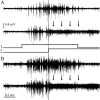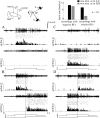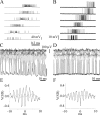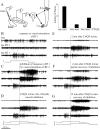A cholinergic gating mechanism controlled by competitive interactions in the optic tectum of the pigeon
- PMID: 17652602
- PMCID: PMC6672716
- DOI: 10.1523/JNEUROSCI.1420-07.2007
A cholinergic gating mechanism controlled by competitive interactions in the optic tectum of the pigeon
Abstract
We describe the operation of a midbrain neural circuit in pigeons that may participate in selecting and attending to one visual stimulus from the myriad displayed in their visual environment. This mechanism is based on a topographically organized cholinergic signal reentering the optic tectum (TeO). We have shown previously that, whenever a visual stimulus activates neurons in a given tectal location, this location receives a strong bursting feedback from cholinergic neurons of the nucleus isthmi pars parvocellularis (Ipc), situated underneath the tectum. Here we show that, if a second visual stimulus is presented, even far from the first, the feedback signal to the first tectal location is diminished or suppressed, and feedback to the second tectal location is initiated. We found that this long-range suppressive interaction is mostly mediated by the nucleus isthmi pars magnocellularis, which sends a wide-field GABAergic projection to Ipc and TeO. In addition, two sets of findings indicate that the feedback from the Ipc modulates the ascending output from the TeO. First, visually evoked extracellular responses recorded in the dorsal anterior subdivision of the thalamic nucleus rotundus (RtDa), receiving the ascending tectal output, are closely synchronized to this feedback signal. Second, local inactivation of the Ipc prevents visual responses in RtDa to visual targets moving in the corresponding region of visual space. These results suggest that the ascending transmission of visual activity through the tectofugal pathway is gated by this cholinergic re-entrant signal, whose location within the tectal visual map is dynamically defined by competitive interactions.
Figures








Similar articles
-
Attentional capture? Synchronized feedback signals from the isthmi boost retinal signals to higher visual areas.J Neurosci. 2012 Jan 18;32(3):1110-22. doi: 10.1523/JNEUROSCI.4151-11.2012. J Neurosci. 2012. PMID: 22262908 Free PMC article.
-
Oscillatory bursts in the optic tectum of birds represent re-entrant signals from the nucleus isthmi pars parvocellularis.J Neurosci. 2005 Jul 27;25(30):7081-9. doi: 10.1523/JNEUROSCI.1379-05.2005. J Neurosci. 2005. PMID: 16049185 Free PMC article.
-
Magnocellular and parvocellular divisions of pigeon nucleus isthmi differentially modulate visual responses in the tectum.Exp Brain Res. 1995;104(3):376-84. doi: 10.1007/BF00231973. Exp Brain Res. 1995. PMID: 7589290
-
The nucleus isthmi and dual modulation of the receptive field of tectal neurons in non-mammals.Brain Res Brain Res Rev. 2003 Jan;41(1):13-25. doi: 10.1016/s0165-0173(02)00217-5. Brain Res Brain Res Rev. 2003. PMID: 12505645 Review.
-
Dual coding of visual asymmetries in the pigeon brain: the interaction of bottom-up and top-down systems.Exp Brain Res. 2009 Dec;199(3-4):323-32. doi: 10.1007/s00221-009-1702-z. Exp Brain Res. 2009. PMID: 19153723 Review.
Cited by
-
Extracellular recordings reveal absence of magneto sensitive units in the avian optic tectum.J Comp Physiol A Neuroethol Sens Neural Behav Physiol. 2014 Dec;200(12):983-96. doi: 10.1007/s00359-014-0947-6. Epub 2014 Oct 4. J Comp Physiol A Neuroethol Sens Neural Behav Physiol. 2014. PMID: 25281335 Free PMC article.
-
Response normalization in the superficial layers of the superior colliculus as a possible mechanism for saccadic averaging.J Neurosci. 2014 Jun 4;34(23):7976-87. doi: 10.1523/JNEUROSCI.3022-13.2014. J Neurosci. 2014. PMID: 24899719 Free PMC article.
-
A dedicated visual pathway for prey detection in larval zebrafish.Elife. 2014 Dec 9;3:e04878. doi: 10.7554/eLife.04878. Elife. 2014. PMID: 25490154 Free PMC article.
-
Donut-like organization of inhibition underlies categorical neural responses in the midbrain.Nat Commun. 2022 Mar 30;13(1):1680. doi: 10.1038/s41467-022-29318-0. Nat Commun. 2022. PMID: 35354821 Free PMC article.
-
Combinatorial Neural Inhibition for Stimulus Selection across Space.Cell Rep. 2018 Oct 30;25(5):1158-1170.e9. doi: 10.1016/j.celrep.2018.10.022. Cell Rep. 2018. PMID: 30380408 Free PMC article.
References
-
- Appell PP, Behan M. Sources of subcortical GABAergic projections to the superior colliculus in the cat. J Comp Neurol. 1990;302:143–158. - PubMed
-
- Binns KE, Salt TE. The functional influence of nicotinic cholinergic receptors on the visual responses of neurones in the superficial superior colliculus. Vis Neurosci. 2000;17:283–289. - PubMed
-
- Carello CD, Krauzlis RJ. Manipulating intent: evidence for a causal role of the superior colliculus in target selection. Neuron. 2004;43:575–583. - PubMed
Publication types
MeSH terms
LinkOut - more resources
Full Text Sources
Other Literature Sources
Miscellaneous
